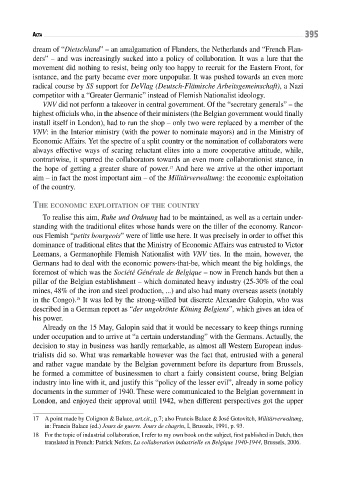Page 395 - Conflitti Militari e Popolazioni Civili - Tomo I
P. 395
395
aCta
dream of “Dietschland” – an amalgamation of Flanders, the Netherlands and “French Flan-
ders” – and was increasingly sucked into a policy of collaboration. It was a lure that the
movement did nothing to resist, being only too happy to recruit for the Eastern Front, for
isntance, and the party became ever more unpopular. It was pushed towards an even more
radical course by SS support for DeVlag (Deutsch-Flämische Arbeitsgemeinschaft), a Nazi
competitor with a “Greater Germanic” instead of Flemish Nationalist ideology.
VNV did not perform a takeover in central government. Of the “secretary generals” – the
highest officials who, in the absence of their ministers (the Belgian government would finally
install itself in London), had to run the shop – only two were replaced by a member of the
VNV: in the Interior ministry (with the power to nominate mayors) and in the Ministry of
Economic Affairs. Yet the spectre of a split country or the nomination of collaborators were
always effective ways of scaring reluctant elites into a more cooperative attitude, while,
contrariwise, it spurred the collaborators towards an even more collaborationist stance, in
the hope of getting a greater share of power. and here we arrive at the other important
17
aim – in fact the most important aim – of the Militärverwaltung: the economic exploitation
of the country.
the ecOnOMic eXPlOitatiOn Of the cOuntry
to realise this aim, Ruhe und Ordnung had to be maintained, as well as a certain under-
standing with the traditional elites whose hands were on the tiller of the economy. Rancor-
ous Flemish “petits bourgeois” were of little use here. It was precisely in order to offset this
dominance of traditional elites that the Ministry of Economic Affairs was entrusted to Victor
leemans, a Germanophile Flemish Nationalist with VNV ties. in the main, however, the
Germans had to deal with the economic powers-that-be, which meant the big holdings, the
foremost of which was the Société Générale de Belgique – now in French hands but then a
pillar of the Belgian establishment – which dominated heavy industry (25-30% of the coal
mines, 48% of the iron and steel production, ...) and also had many overseas assets (notably
in the Congo). It was led by the strong-willed but discrete Alexandre Galopin, who was
18
described in a German report as “der ungekrönte Köning Belgiens”, which gives an idea of
his power.
Already on the 15 May, Galopin said that it would be necessary to keep things running
under occupation and to arrive at “a certain understanding” with the Germans. Actually, the
decision to stay in business was hardly remarkable, as almost all Western European indus-
trialists did so. What was remarkable however was the fact that, entrusted with a general
and rather vague mandate by the Belgian government before its departure from Brussels,
he formed a committee of businessmen to chart a fairly consistent course, bring Belgian
industry into line with it, and justify this “policy of the lesser evil”, already in some policy
documents in the summer of 1940. These were communicated to the Belgian government in
London, and enjoyed their approval until 1942, when different perspectives got the upper
17 A point made by Colignon & Balace, art.cit., p.7; also Francis Balace & José Gotovitch, Militärverwaltung,
in: Francis Balace (ed.) Jours de guerre. Jours de chagrin, i, Brussels, 1991, p. 93.
18 For the topic of industrial collaboration, I refer to my own book on the subject, first published in Dutch, then
translated in French: Patrick Nefors, La collaboration industrielle en Belgique 1940-1944, Brussels, 2006.

